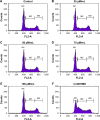Synthesis of biocompatible iron oxide nanoparticles as a drug delivery vehicle
- PMID: 29593401
- PMCID: PMC5863622
- DOI: 10.2147/IJN.S124708
Synthesis of biocompatible iron oxide nanoparticles as a drug delivery vehicle
Erratum in
-
Erratum: Synthesis of biocompatible iron oxide nanoparticles as a drug delivery vehicle [Corrigendum].Int J Nanomedicine. 2018 Jul 19;13:4207-4208. doi: 10.2147/IJN.S178426. eCollection 2018. Int J Nanomedicine. 2018. PMID: 30050298 Free PMC article.
Abstract
Over the last decade, there has been growing interest in developing novel nanoparticles (NPs) for biomedical applications. A safe-by-design approach was used in this study to synthesize biocompatible iron oxide NPs. The size of the particles obtained was ~100 nm. Although these NPs were significantly (P<0.05) internalized in MCF-7 (human breast adenocarcinoma cell line) cells, no adverse effect was observed in the cells as assessed by cytotoxicity assays (neutral red uptake and 3-[4,5-dimethylthiazol-2-yl]-2,5-diphenyltetrazolium bromide) and cell cycle analysis. Our data demonstrate the potential of iron oxide NPs as a biocompatible carrier for targeted drug delivery.
Keywords: biocompatible iron oxide nanoparticles; coprecipitation; human breast adenocarcinoma cells.
Conflict of interest statement
Disclosure The authors report no conflicts of interest in this work.
Figures



References
-
- Chin SF, Iyer KS, Saunders M, et al. Encapsulation and sustained release of curcumin using superparamagnetic silica reservoirs. Chemistry. 2009;15(23):5661–5665. - PubMed
-
- Liu G, Wang Z, Lu J, et al. Low molecular weight alkyl-polycation wrapped magnetite nanoparticle clusters as MRI probes for stem cell labelling and in vivo imaging. Biomaterials. 2011;32(2):528–537. - PubMed
-
- Dandamudi S, Campbell RB. The drug loading, cytotoxicity and tumor vascular targeting characteristics of magnetite in magnetic drug targeting. Biomaterials. 2007;28(31):4673–4683. - PubMed
-
- Pan BF, Gao F, Gu HC. Dendrimer modified magnetite nanoparticles for protein immobilization. J ColloidInterface Sci. 2005;284(1):1–6. - PubMed
-
- Hariani PL, Faizal M, Ridwan, Marsi, Setiabudidaya D. Synthesis and properties of Fe3O4 nanoparticles by co-precipitation method to removal procion dye. Int J Environ Sci Develop. 2013;4(3):336–340.
MeSH terms
Substances
LinkOut - more resources
Full Text Sources
Other Literature Sources

